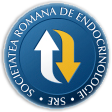
- Login
- Register
- Home/Current Issue
- About the journal
- Editorial board
- Online submission
- Instructions for authors
- Subscriptions
- Foundation Acta Endocrinologica
- Archive
- Contact
 Romanian Academy
Romanian Academy
 The Publishing House of the Romanian Academy
The Publishing House of the Romanian Academy

ACTA ENDOCRINOLOGICA (BUC)
The International Journal of Romanian Society of Endocrinology / Registered in 1938in Web of Science Master Journal List
Acta Endocrinologica(Bucharest) is live in PubMed Central
Journal Impact Factor - click here.

-
Case Report
Braha E, Sireteanu A., Vulpoi C., Gorduza C., Branisteanu D., Popescu R., Badiu C., Rusu C
Clinical and Endocrine Aspects of Five Prader Willi PatientsActa Endo (Buc) 2013 9(3): 455-466 doi: 10.4183/aeb.2013.455
AbstractPrader Willi syndrome is a complex disease caused by the lack of expression of paternally inherited imprinted genes on chromosome 15q11.2-q13. Typical clinical features are hypotonia and feeding difficulties in infancy, followed by hyperphagia and progressive obesity, distinctive dysmorphic features, intellectual disability and behavioural problems. In this paper we present clinical, metabolic and endocrine aspects in five genetically confirmed patients with PWS. Data about thyroid dysfunction, GH deficiency, adrenal insufficiency, and LH/FSH disorder caused by hypothalamic dysfunction in PWS were collected and analyzed. Cardiovascular metabolic profile was also assessed, based on plasma lipids, blood glucose, HbA1c values, and measurements of body weight and blood pressure. Clinical features present in all our patients were marked hypotonia and feeding difficulties in infancy, obesity, dysmorphic face, viscous saliva, small hands and feet, intellectual disability and characteristic behaviour. Adrenal function appeared to be normal in all patients; mild hypothyroidism was identified in one patient; sex development abnormalities were present in three patients and GH levels were within lower normal range in all patients. GH therapy was initiated in two patients, both with unevolutive skeletal anomalies, with good results and no side-effects. Only one patient had a normal lipid profile, underlying the importance of early detection and treatment of cardiovascular risk factors. Our study also illustrates the challenges raised by some features very rarely described in PWS (Blount disease and multiple allergies). -
Clinical review/Extensive clinical experience
Serafinceanu C, Timar R, Catrinoiu D, Zaharia A
Choice of the Add-on Therapy to Metformin in Type 2 Diabetes Patients in Clinical Practice. Initial Results from a Non-Interventional Multicenter Study in Romania (REALITY)Acta Endo (Buc) 2016 12(4): 455-460 doi: 10.4183/aeb.2016.455
AbstractMetformin, a biguanide, remains the most widely used first-line type 2 diabetes drug. It is generally considered weight-neutral with chronic use and does not increase the risk of hypoglycaemia. Most patients eventually require more than one antihyperglycemic agent to achieve target blood glucose levels. The primary objective of this non-interventional study was to describe and compare the main criteria used by physicians from regular outpatient setting in selecting the add-on therapy in patients with inadequately metformincontrolled type 2 diabetes in 2 time points at 1-year distance by assessment of patient, and/or agent characteristics and/or physician decision. At the end of phase one of the study, the mean duration of type 2 diabetes was 6.8 years. The majority of patients included in the study were overweight (32%) and obese (62%), and presented diabetes complications (59.6%). In 50% of the cases, the major reason for selecting the second-line therapy was related to patient characteristics, while agent characteristics and physician decision were the main categories in 38% and 12%, respectively. Importance to achieve glycemic control and estimated treatment efficacy were selected in 73.9% and 82.4% of patients, calculated as percentage in the respective categories. -
Endocrine Care
Zosin I, Balas M, Golu I, Vonica O, Badescu L, Ursoniu S
Diagnostic approaches in a series of cases with Graves' ophthalmopathyActa Endo (Buc) 2010 6(4): 455-464 doi: 10.4183/aeb.2010.455
AbstractIntroduction. The definition of severity and activity of Graves' ophthalmopathy (GO)comprises different parameters.\r\nThe aim of this study is to select the most appropriate severity and activity criteria, respectively scores and to investigate a possible correlation among them.\r\nSubjects and methods. The study included 51 patients with GO (43 females, 8 males), mean age 46.8?11.2 years. The patients were evaluated by: clinical exam, laboratory\r\nparameters (TSH, FT4, FT3, thyroid autoantibodies) and imagistic means, performed in selected cases (CT or MRI).\r\nResults. The GO activity was assessed by the clinical activity score (CAS). We quantified the EUGOGO severity criteria, by allotting points for each selected parameter.\r\nAccording to the recommended criteria, the cases were divided into active (n=26) and inactive forms (n=25). There were no significant statistical differences regarding CAS\r\nbetween euthyroid cases (n=14) and dysthyroid cases (n=37). Serum thyroid receptor antibodies (TRAb) levels did not correlate with CAS or severity scores. Severity scores\r\ncorrelated significantly with CAS (Pearson correlation index 0.546, r2=0.290, p=0.0001).\r\nConclusion. Active forms of GO showed higher severity scores than the inactive ones. The severity scores correlated significantly with CAS scores. Neither CAS, nor severity scores correlated significantly with the severity of thyrotoxicosis. -
Endocrine Care
Batman A, Canat MM, Saygili ES, Besler E, Yildiz D, Yener Ozturk F, Altuntas Y
Risk Factors for Acute Kidney Injury Associated with Severe HypothyroidismActa Endo (Buc) 2023 19(4): 456-462 doi: 10.4183/aeb.2023.456
AbstractObjective. This study aims to investigate the factors affecting development of acute kidney injury (AKI) in patients with severe hypothyroidism. Methods. This retrospective observational study involved patients with primary hypothyroidism and thyroid stimulating hormone (TSH) levels of more than 50 mIU/L at their review in the endocrinology outpatient clinic, between January 2015 and April 2021. Factors affecting the development of AKI were examined by logistic regression analysis. Results. A total of 100 patients, 20 (11 male (M), 9 female (F)) in the AKI (case) group and 80 (23 M, 57 F) patients in control group, were included in our study. The median age of the case group (56 years, interquartile range (IQR) 44.3–68.5) was significantly higher than the control group (49 years, IQR 32.3–60; p = 0.027), and the ratio of males to females was significantly higher in the case group (p = 0.001). Multivariate logistic regression analyses showed that hypothyroidism diagnosed after the age of 60 years (odds ratio (OR) 59.674, 95% confidence intervals (CI) 5.955–598.031; p = 0.001), free triiodothyronine (FT3) < 1.3 pg/mL (OR 17.151, 95% CI 2.491–118.089; p = 0.004) and creatine kinase (CK) > 1000 U/L (OR 1.522, 95% CI 1.602– 82.848; p = 0.015) were predictors for the development of AKI in patients with severe hypothyroidism. Conclusion. We recommend close follow-up and monitoring of patients with AKI caused by severe hypothyroidism if patients who are diagnosed at age > 60 years, CK > 1000 U/L or FT3 < 1.3 pg/mL. -
Endocrine Care
Velicescu C, Branisteanu D, Grigorovici A, Gatu A, Preda C, Mogos V, Danila R
Quick Intraoperative PTH Assay Improves Cure Rate of Minimally Invasive Surgery in Patients with Primary HyperparathyroidismActa Endo (Buc) 2015 11(4): 457-462 doi: 10.4183/aeb.2015.457
AbstractPurpose. We checked the advantage of intraoperative quick PTH (iqPTH) for improving cure rate of patients operated for primary hyperparathyroidism (PHPTH) by using minimally invasive surgery. Methods. We compared two groups of patients diagnosed with PHPTH by preoperatory localized single parathyroid adenoma (PA) submitted to minimal invasive surgery with histological confirmation. Patients from a control group (C) were operated without measuring intraoperative PTH, whereas in the second group iqPTH was assessed after adenoma excision and before wound suture. When quick PTH dropped less than 50%, conversion to open surgery and bilateral exploration followed. Results. Six of the 40 patients from the C group (15%) had persistently elevated postoperative PTH, needing reintervention. High intraoperative PTH levels persisted in two of the 13 patients from the iqPTH group (15.4%), but conversion to open surgery allowed localizing and excision of preoperatory undetected supplementary PA, increasing success rate to 100% (p < 0.05). Conclusions. Assessment of iqPTH in PHPTH before wound suture provides reliable confirmation of accurate adenoma removal. Persistence of high PTH levels after adenoma removal suggests multiple gland disease and requires conversion to bilateral neck exploration in order to increase cure rate. -
Case Report
Dumitrescu C, Ionescu M, Ioachim D, Procopiuc C, Popa M
Childhood thyroid carcinoma: two cases with unusual associationsActa Endo (Buc) 2006 2(4): 457-463 doi: 10.4183/aeb.2006.457
AbstractThyroid carcinoma is rare in children and adolescents and has a relatively favorable prognosis. As in adults, the incidence in girls is double than in boys. It has a little risk of mortality, but a high risk of recurrence. Patients younger than 15 years old at diagnosis are considered more likely to have more extensive tumor at diagnosis than patients who are 15 years and older. We report two patients: an 11 years old girl with Fallot tetrallogy and papillary thyroid cancer and a 13 years old girl with Graves’ disease treated with antithyroid drugs for three years and thyroidectomized at 17 years old with an incidental thyroid microcarcinoma. Those unusual associations are discussed regarding therapy and follow-up issues. -
Endocrine Care
Demiral M, Celebi HBG, Cander S, Yerci O, Eren E, Demirbilek H
Two Opposite Phenotypes of Glucose Disorders in a Family with Heterozygous P.SER453LEU (C.1358C> T) Mutation in the Glucokinase (GCK) Gene: Maturity Onset Diabetes in Young and InsulinomaActa Endo (Buc) 2022 18(4): 458-465 doi: 10.4183/aeb.2022.458
AbstractBackground. Heterozygous gain-of-function mutations in the glucokinase (GCK) gene cause hyperinsulinaemic hypoglycaemia (GCK-HI), while lossof- function mutations lead to a monogenic type of diabetes (GCK-MODY). We, herein, report a heterozygous GCK gene mutation in a large family with GCK-MODY and insulinoma in one individual from the same family. Patients and methods. The proband, an 11-yearold male, was referred for asymptomatic mild hyperglycemia (fasting glucose:121 mg/dL) and HbA1c of 6.1%. Segregation analysis of the family revealed multiplex members with asymptomatic fasting hyperglycaemia or non-insulindependent diabetes and 33-year-old maternal uncle of the proband case had a history of distal pancreatectomy due to the diagnosis of insulinoma. His preoperative investigations were revealed fasting glucose of 31 mg/dL, insulin: 7μU/ mL, C-peptide: 2.6 mg/dL, and a low HbA1c(4.0%) which was suggestive for recurring hypoglycaemia episodes. Postpancreatectomy he developed mild fasting hyperglycemia (115-136 mg/dL). Results. Genetic analysis revealed heterozygous p.Ser453Leu(c.1358C> T) mutation in the GCK gene in the proband. In segregation analysis, the identical heterozygous p.Ser453Leu(c.1358C> T) GCK gene mutation was detected in all of the other affected family members for whom a DNA analysis was applicable. The maternal uncle was first diagnosed with insulinoma and underwent a pancreatectomy. He also had an identical mutation in a heterozygous state. Conclusion. We, to the best of our knowledge, firstly identified these two entirely distinct phenotypes of glucose metabolism, GCK-MODY and GCK-HI, due to an identical heterozygous p.Ser453Leu (c.1358C> T) mutation in the GCK. Further studies required to elucidate this new phenomenon and understanding the genotype-phenotype relationship of GCK gene mutations. -
General Endocrinology
Sözen MA, Ozcan MU, Cildir M, Dogru IH, Aygok AG, Balkan KU
Association of the Human PPARY2 PRO12ALA Polymorphism with Obesity in a Population from TurkeyActa Endo (Buc) 2018 14(4): 459-465 doi: 10.4183/aeb.2018.459
AbstractBackground. There have been a number of reports on the relationship between the PPARγ2 Pro12Ala genotype and the development of obesity. Objective. A case-control survey was designed to investigate the potential association between a Pro12Ala polymorphism in the PPARγ2 gene and obesity and/or obesity-related phenotypes in a population from Turkey. Materials and methods. The polymerase chain reaction and restriction enzyme digestion were used to genotype the Pro12Ala polymorphism of the PPARγ2 gene in 149 unrelated obese and 105 non-obese control subjects from Turkey. The data were analyzed statistically. Results. We found that the overall minor allele frequency was 0.12 in cases and 0.095 in controls. In terms of genotype distribution and allele frequencies among the cases versus controls in the population studied, only the genderstratified analysis revealed a significantly higher frequency of Pro/Ala genotype within males. The polymorphism was associated with significantly higher weight, height, waist circumference, central adiposity (waist-to-hip ratio, WHR), lean body weight as well as dry body weight, but not overall adiposity (total body fat percentage, TBF) in cases carrying Ala allele (Pro/Ala or Ala/Ala). However, in the subjects carrying Ala allele of the control group, WHR values were found significantly lower. Conclusion. Our results showed that the Pro12Ala polymorphism in the PPARγ2 gene is associated with obesity in the studied adult population from Turkey. These data suggest that the Pro12Ala polymorphism in PPARγ2 may be a potential genetic risk factor for central obesity. -
Endocrine Care
Raica M, Muresan AM, Cimpean AM, Suciu C
Clinical significance of androgen receptor expression in breast cancerActa Endo (Buc) 2009 5(4): 459-469 doi: 10.4183/aeb.2009.459
AbstractBackground. Androgen receptor (AR) plays a crucial role in the homeostasis of\r\nmammary tissue. In the present study we investigated the immunohistochemical expression\r\nof AR in breast cancer and its relationships with clinico-pathological parameters of\r\nprognosis, hormone receptors status and HER2 overexpression.\r\nMethods. There were investigated 124 patients admitted with invasive breast cancer,\r\nand from these 48 had lymph node metastasis and 9 had distant metastasis. In all specimens\r\nthere were performed immunohistochemical staining for AR, estrogen receptors (ER),\r\nprogesterone receptor (PR) and HER2. Results were correlated with pathological findings\r\nand the molecular profile of the tumors.\r\nResults. The immunohistochemical expression for AR was found in 92 cases. A\r\nsignificant correlation was found between AR expression and pathological type, grade and\r\nlymph node status, but not with distant metastasis and the expression of ER, PR and HER2.\r\nAn inverse correlation was found between AR expression and triple negative breast cancers.\r\nConclusion. Our data suggest that AR is an individual factor of prognosis and is a\r\nuseful marker to stratify patients with triple negative tumors. AR could be a potential target\r\nfor specific therapy in individuals excluded from the conventional hormone therapy. -
Endocrine Care
Ozcelik S, Bas S, Ozcelik M, Sariaydin M, Celik M, Gozu H
Efficacy of Insulin, Heparin and Fenofibrate Combination Treatment in Severe Hypertriglyceridemia: Double Center ExperienceActa Endo (Buc) 2019 15(4): 460-465 doi: 10.4183/aeb.2019.460
AbstractContext. Severe hypertriglyceridemia (SH), which calls for a triglyceride (TG) level above 1000 mg/dL, remains an important health issue. While some data exist to offer combination of heparin, insulin and fenofibrate as a reasonable treatment option, safety and benefits of this therapy have not been accurately weighted, largely due to the limited sample size of the relevant studies. Aim. Assess the efficacy and safety of the heparin, insulin and fenofibrate combination in the treatment of patients with SH. Patients - Methods. Patients aged ≥18 years with TG level above 1000 mg/dL and adequate organ function were included. Triglyceride levels were measured immediately before the treatment and on the 3rd and 6th days of the treatment. Treatment dosage, duration, response and side effects were assessed. Patients with hypertriglyceridemia presenting with acute pancreatitis were treated additionally with lipid apheresis. Results. A total of 42 patients were included. Of these, 85.8% came to medical attention with some kind of secondary hypertriglyceridemia causes. The baseline median TG value of the cases was 2141.0 mg/ dL (1026-12250). There were 6 patients (14.3%) with acute pancreatitis at presentation. In patients without pancreatitis, with administration of insulin infusion, unfractionated heparin infusion and fenofibrate capsule, median TG values decreased to 921 mg/ dL (190-6400) on the 3rd day and to 437 mg/ dL (112-1950) on the 6th day of the treatment (p<0.0001, Friedman test). Potential toxicities related to insulin, heparin and fenofibrate combination treatment including hypoglycemia, hemorrhage, rise in creatine kinase levels, hepato - and nephrotoxicity were not observed. Conclusion. In this trial involving patients with SH, our data suggest that insulin, heparin and fenofibrate combination therapy was safe and effective.